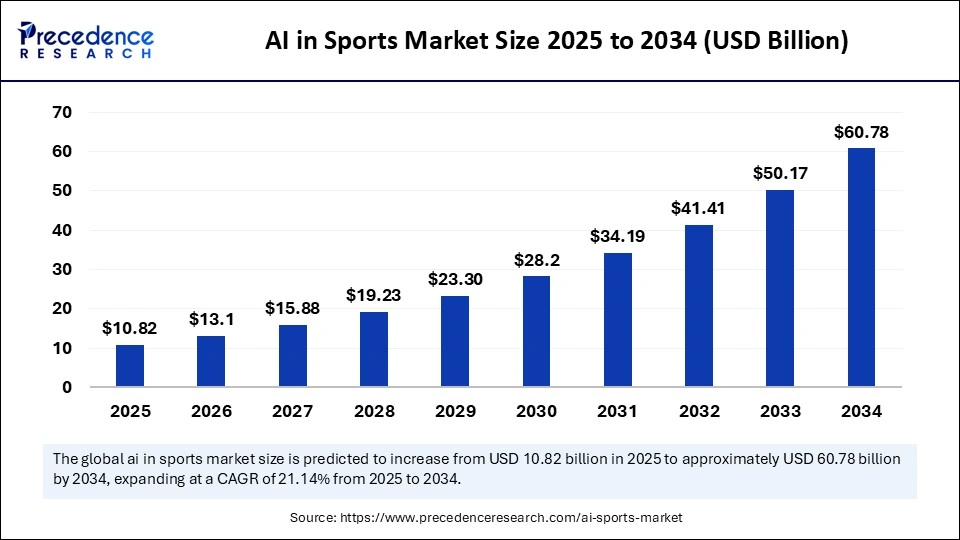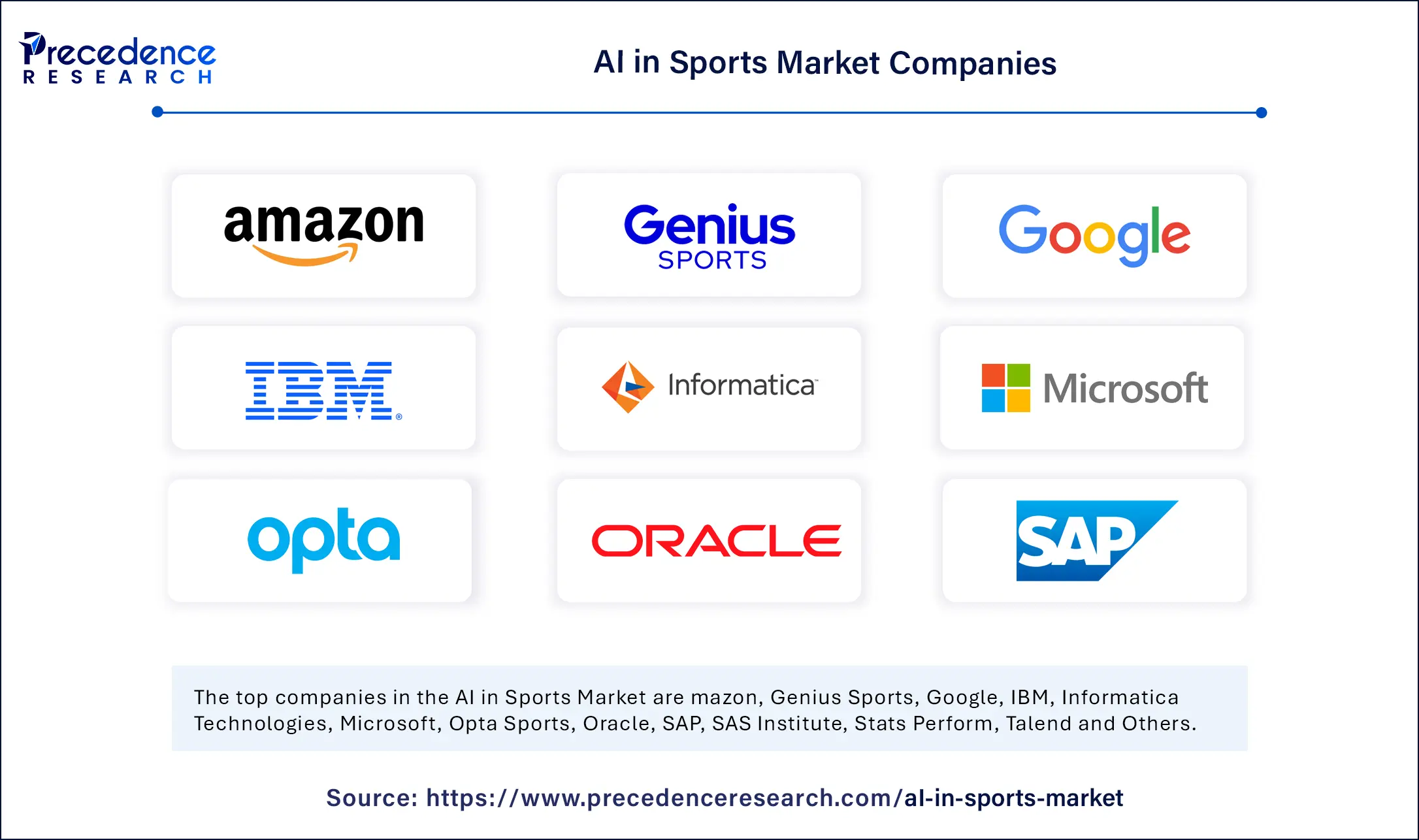
AI in Sports Market Key Points
-
North America led the global AI in sports market in 2024, holding the largest share of 35%.
-
Europe is projected to grow at the fastest CAGR from 2025 to 2034.
-
By type of AI technology, the machine learning segment held the dominant market share in 2024.
-
The computer vision segment, under AI technology type, is anticipated to grow at a significant CAGR during the forecast period.
-
In terms of application, the performance analysis segment accounted for the largest market share in 2024.
-
The fan engagement segment, by application, is expected to witness robust CAGR growth in the coming years.
-
By sport, the soccer segment captured the highest share of the market in 2024.
-
The basketball segment, under sport category, is projected to grow at a notable CAGR throughout the forecast period.
-
Based on end-user, the athletes segment represented the largest share in 2024.
-
The leagues segment, by end-user, is forecasted to expand at a notable CAGR between 2025 and 2034.
AI in Sports Market Overview
The AI in sports market is undergoing significant transformation as artificial intelligence (AI) technologies become deeply embedded across the sports ecosystem—from athlete training and performance analytics to fan engagement, broadcasting, injury prevention, and business operations. Sports organizations, teams, broadcasters, and tech companies are increasingly leveraging AI to gain competitive advantages, enhance the spectator experience, and drive monetization in an industry characterized by intense competition and global appeal. AI applications in sports are diverse, including real-time game analytics, computer vision for motion tracking, predictive modeling for player performance, automated highlights generation, and personalized fan content.
With the increasing availability of data from wearable sensors, video footage, ticketing platforms, and social media, AI is helping to unlock actionable insights at scale and speed. This has ushered in a new era of data-driven decision-making in sports management, training regimens, and marketing. From elite-level professional leagues to amateur and youth sports, AI is being deployed to maximize performance, reduce injury risks, enhance scouting and recruitment processes, and elevate fan interactivity through smart devices and virtual environments. As a result, the market for AI in sports is experiencing robust growth, with rising investments from technology providers, venture capitalists, and sports franchises aiming to capitalize on this digital disruption.
AI in Sports Market Growth Factors
Several structural trends are accelerating the growth of the AI in sports market. A major growth factor is the explosion of real-time data collection from wearables, connected devices, and high-definition cameras. Modern athletes are being tracked on multiple physiological and biomechanical parameters, and AI algorithms are used to analyze this data for performance optimization, fatigue management, and personalized training. The demand for enhanced athletic performance and injury prevention has pushed teams and sports medicine practitioners to invest in AI-powered platforms capable of offering early warning signs based on movement patterns and biometrics.
Another powerful growth factor is the increasing commercial pressure on sports organizations to enhance fan engagement in a digital-first world. With consumers expecting immersive, real-time, and personalized experiences, AI is enabling dynamic content delivery, tailored advertisements, smart ticketing, and automated customer interaction—fostering deeper connections with fans both in-stadium and online. Additionally, rising investments from sports tech startups, broadcasters, and media companies are fueling the development of AI-driven applications, from automated commentary and 3D replays to virtual coaching platforms.
Moreover, the growing need for fair play and officiating transparency is driving the adoption of AI in refereeing decisions and rule enforcement, such as ball tracking, offside detection, and goal-line technology. These advancements not only improve the integrity of the game but also provide viewers with engaging visualizations and deeper game insights.
Impact of AI on the AI in Sports Market
AI is fundamentally reshaping the sports industry by augmenting human capabilities with predictive intelligence, real-time analytics, and automation. In athlete performance, AI applications are analyzing vast datasets derived from GPS trackers, heart-rate monitors, and motion sensors to tailor training plans, detect anomalies in form, and optimize recovery cycles. AI-based video analysis platforms can break down game footage to provide actionable feedback to coaches and players, streamlining tactical planning and opponent analysis.
In fan engagement, AI is enabling hyper-personalization through recommendation engines and natural language processing (NLP). These technologies curate content, merchandise suggestions, and live match notifications based on user behavior, preferences, and location. Chatbots powered by AI also deliver real-time updates, ticket booking assistance, and customer service, improving the digital fan experience.
AI is also disrupting sports broadcasting and media, automating highlight reel generation, camera angle selection, and real-time captioning, reducing manual labor and production costs. Furthermore, AI is transforming sports betting and fantasy leagues, using predictive analytics to set odds, forecast outcomes, and recommend fantasy rosters based on historical and real-time player data.
Importantly, AI contributes to injury prevention and rehabilitation by identifying risk patterns, recommending adjustments to biomechanics, and monitoring recovery progress. This holistic impact across athlete management, fan interaction, and operations positions AI as a strategic enabler of innovation and efficiency in sports.
Market Drivers
Several key drivers are fueling the demand for AI in the sports market. One major driver is the competitive advantage AI offers in athlete performance and team strategy, enabling coaches to make informed decisions and reduce the guesswork in game planning. Sports franchises are increasingly adopting AI not only to enhance performance but also to gain insights into player value, fitness levels, and transfer potential—driving smarter recruitment and contract negotiations.
The digitization of sports viewership and the proliferation of OTT (over-the-top) platforms have created new avenues for content monetization, with AI playing a crucial role in video indexing, audience targeting, and viewer retention. Similarly, the rise of eSports and virtual sports leagues, where performance and engagement are entirely driven by digital technologies, is providing fertile ground for AI implementation.
Additionally, the globalization of sports and rising fan expectations have intensified the need for innovative engagement models. Sports organizations are turning to AI to deliver immersive experiences using AR/VR, personalized mobile apps, and digital collectibles (e.g., NFTs). Finally, increasing partnerships between sports leagues and tech giants (such as IBM with Wimbledon or AWS with the NFL) are facilitating access to advanced AI infrastructure and analytics platforms, accelerating adoption across all levels of professional sports.
Opportunities
The AI in sports market presents numerous opportunities for stakeholders across the value chain. A significant opportunity lies in expanding AI adoption to youth, amateur, and college sports, where affordable AI-powered coaching and performance tools can democratize access to elite-level training. Companies offering cloud-based, subscription models for video analysis, training apps, or injury monitoring can tap into this underpenetrated segment.
Another key opportunity is the development of AI-based virtual coaches and training assistants that use computer vision to assess athlete movements and provide real-time feedback, making personalized coaching scalable and accessible even outside traditional sports facilities. This is especially relevant in post-pandemic hybrid training models and remote coaching setups.
As sports betting continues to grow, AI’s role in data-driven odds setting and fraud detection is becoming indispensable. Similarly, sponsorship analytics platforms powered by AI can help brands measure ROI from sports sponsorships through sentiment analysis, social media tracking, and fan demographics modeling.
AI also presents immense potential in sustainability and venue management, using predictive analytics for crowd control, energy optimization, and waste reduction during large-scale sporting events. Moreover, the integration of AI with Web3 and immersive fan experiences (e.g., AI-powered avatars in virtual stadiums) offers long-term growth avenues in the evolving sports metaverse.
Challenges
Despite the promising outlook, several challenges hinder the rapid adoption of AI in sports. One of the major barriers is the lack of standardized data infrastructure and interoperability across leagues, teams, and device manufacturers. Disconnected systems make it difficult to scale AI applications and extract consistent insights.
Another concern is data privacy and ethical considerations, especially with regard to athlete tracking, biometric data usage, and performance monitoring. Athletes and staff may raise concerns over surveillance, autonomy, and the use of AI to make career-impacting decisions.
The cost of implementation, particularly in small or mid-tier teams, can also be prohibitive. AI solutions often require specialized hardware (e.g., cameras, wearables) and software, along with trained personnel to manage and interpret data. This can limit adoption to elite-level teams with higher budgets.
Moreover, bias in AI algorithms, especially in recruitment or scouting tools, poses risks of reinforcing stereotypes or excluding diverse talent pools. Ensuring transparency, accountability, and fairness in AI models is critical for maintaining the integrity of sports decision-making.
Regional Outlook
North America is currently the leading region in AI in sports adoption, thanks to the presence of major sports leagues (NFL, NBA, MLB, NHL), advanced infrastructure, and significant investments from tech giants and sports analytics firms. The U.S. market is especially strong in player tracking, injury prevention systems, and fan engagement platforms.
Europe is also witnessing rapid adoption, particularly in football (soccer), Formula 1, and tennis. Clubs across the UK, Germany, Spain, and Italy are leveraging AI for scouting, tactical planning, and fan monetization. Government-backed initiatives in sports tech innovation and smart stadium development are further enhancing the region’s growth prospects.
Asia Pacific is emerging as a high-growth region, led by countries like China, Japan, South Korea, and India. The rise of digital sports platforms, eSports, and fitness technology in these countries is opening new avenues for AI adoption. Local leagues and sports academies are increasingly investing in video analytics, virtual coaching, and AI-enabled fan engagement tools.
Latin America, with its passionate sports culture, particularly in football and basketball, is gradually embracing AI to support player development and league-level digital transformation. However, infrastructure constraints and budget limitations may slow large-scale implementation.
Middle East & Africa are also making strides, with the UAE, Saudi Arabia, and South Africa promoting sports innovation through national investment strategies. High-profile sporting events like the FIFA World Cup in Qatar have stimulated investments in AI-driven venue management, security, and broadcasting technologies.
AI in Sports Market Companies

- Amazon
- Genius Sports
- IBM
- Informatica Technologies
- Microsoft
- Opta Sports
- Oracle
- SAP
- SAS Institute
- Stats Perform
- Talend
Segments Covered in the Report
By Type of AI Technology
- Machine Learning
- Natural Language Processing
- Computer Vision
- Deep Learning
- Reinforcement Learning
By Application
- Performance Analysis
- Injury Prevention
- Training Optimization
- Fan Engagement
- Stadium Management
By Sport
- Soccer
- Football
- Basketball
- Baseball
- Cricket
- Tennis
- Golf
By End-User
- Athletes
- Coaches
- Teams
- Leagues
- Fans
By Region
- North America
- Europe
- Asia Pacific
- Latin America
- Middle East and Africa
Also Read: Lyophilization Equipment and Services Market
Get this report to explore global market size, share, CAGR, and trends, featuring detailed segmental analysis and an insightful competitive landscape overview @ https://www.precedenceresearch.com/sample/6248
You can place an order or ask any questions, please feel free to contact at sales@precedenceresearch.com|+1 804 441 9344
- Arteriovenous Implants Market Enhance dialysis outcomes with advanced grafts, endovascular access, and AI-assisted precision - September 16, 2025
- Smart Retinal Implants Market Restore vision with wireless bioelectronic prosthetics and AI-powered retinal technologies - September 16, 2025
- Myopia Treatment Devices Market Size to Reach USD 38.51 Billion by 2034, Growing at a CAGR of 7.86% - September 1, 2025
